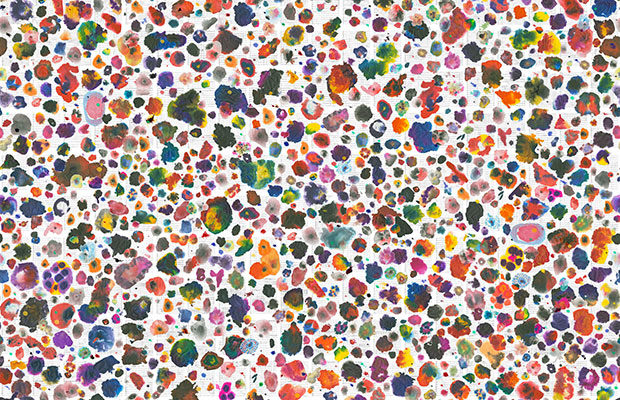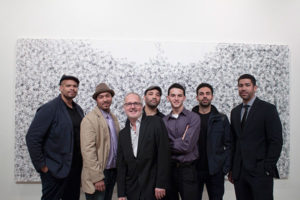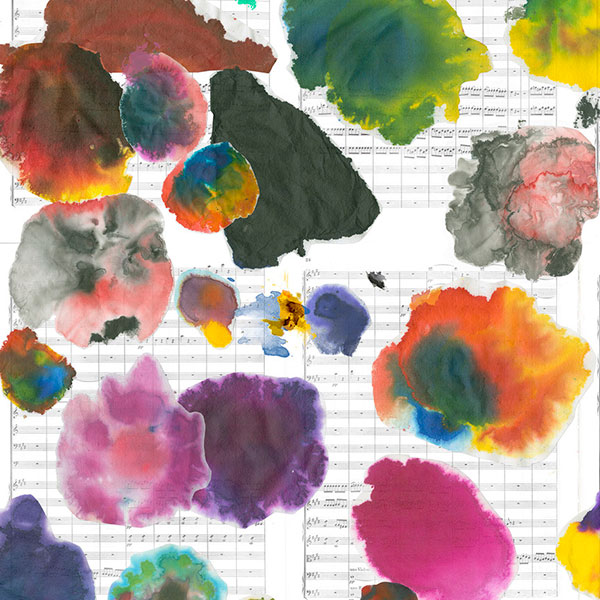 A Midsummer Night’s Dream by Tim Rollins & K.O.S., 2016 | Courtesy Maharam
A Midsummer Night’s Dream by Tim Rollins & K.O.S., 2016 | Courtesy Maharam
Exhibition
Reviving, Surviving: Tim Rollins & K.O.S. at the Portland Museum of Art
“If we pay attention to the fact that there’s great diversity in the way people learn . . . we will create an opportunity for people to be in museums and feel as though they have a stake in them,” says Jessica May, chief curator at the Portland Museum of Art in Maine. The 134-year-old institution has been undergoing a large-scale renovation for the past three years in a bid to make the museum’s collection more accessible and engaging—a project known as Your Museum, Reimagined. As part of that effort, starting this month, the work of collective Tim Rollins and K.O.S. (Kids Of Survival) will be on view in Unbound: Tim Rollins & K.O.S., a special exhibition curated by the museum in collaboration with the artists, while at the same time, a major acquisition by the group, A Midsummer Night’s Dream, will also be unveiled.
Tim Rollins came to New York in 1975 high on the writings of Joseph Kosuth—first studying with and then assisting the conceptual artist at the School of Visual Arts. When Principal George Gallego of Intermediate School 52 contacted him in 1981 about teaching art to at-risk teens in the South Bronx, he jumped at the chance.

Tim Rollins and K.O.S. | Courtesy of the artists and Lehmann Maupin New York and Hong Kong
It was a tough place in a tough city. Angel Abreu, one of Rollins’s students, remembers the three-block stretch that separated his apartment building from I.S. 52 as “treacherous, littered with drug dealers, gangs, and all kinds of really, really bad things,” but he walked it anyway, and looked forward to the bright spot that was Rollins’s art class, in which students gessoed, dyed, and painted over pages from Moby-Dick, The Adventures of Huckleberry Finn, Diary of a Slave Girl, and the poems of Henry Wadsworth Longfellow, among others—turning what could have been rote learning into a playful and creative interaction with classic authors. “We’re making history”—Rollins would tell the students. “That level of respect . . . I’d never had that from an adult before,” Abreu says, “It felt like home.”
Students and teacher eventually outgrew the intellectual confines of public school, and in 1984 Rollins founded the Art and Knowledge Workshop a few blocks from I.S. 52, where he continued to tutor and make art with students. For the hard-working group, “making history” soon didn’t seem like such a long shot. “In the art world in the beginning, particularly, there was a lot of interest in the work,” Rollins says. With his art world savvy and experience—he had also been a founding member of the artist collective Group Material—Tim Rollins & K.O.S. started to bring their work to a larger audience, first to Jay Gorney Modern Art in 1986, and then to museums and international art fairs.
Now with three decades of success under their belt, and after many transformations, their style is mature but protean—with different pieces reminiscent of the work of artists as diverse as Ethelbert White, Raymond Pettibone, and Franz Kline. A Midsummer Night’s Dream is composed of a field of sheet music overlaid with tie-dye-like blotches of color— flowers like the “wild thyme . . . oxlips and the nodding violet . . . luscious woodbine . . . sweet musk-roses and . . . eglantine” eulogized in the play—on Thai mulberry paper. The version of the piece unveiled at PMA is based on an original from 2009 and is being digitally produced by Maharam, the New York–based textile company known for collaborating with designers such as Jasper Morrison, Hella Jongerius, and Konstantin Grcic. The result is much like wallpaper, and for Tim Rollins & K.O.S., who count William Morris as a major influence, it breaks intriguing new ground.

A Midsummer Night’s Dream (detail) by Tim Rollins & K.O.S., 2016 | Courtesy Maharam
Recalling how she presented the piece to the board of trustees, May still can’t decide how to categorize it: “It’s a work of contemporary art . . . but you could also say this is a work of decorative art. We sort of feel like it crosses a lot of boundaries in our collecting strategy.”
Installed in the Selma Wolf Black Great Hall, the approximately 13 by 34-foot piece will be one of the first works visitors see when they enter the museum, an unmistakable symbol of PMA’s desire to expand its collection, provide a platform for Maine-born contemporary artists, and show how art can change lives.
Unbound: Tim Rollins & K.O.S. will be on view at the Portland Museum of Art in Portland, Maine, until December 31. portlandmuseum.org









